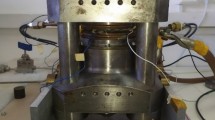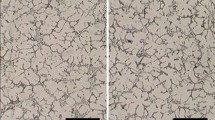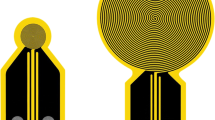Abstract
Using a heat-flow model of a differential thermal analyzer and thermal characteristics obtained by fitting experimental results for a pure metal, the response of the differential thermal analyzer is modeled for the melting and solidification of alloys. The enthalpy-temperature relation used for the alloy simulations is obtained by two different methods: (1) equilibrium and Scheil considerations derived solely from thermodynamic information and (2) solute-diffusion micromodels coupled to the differential thermal analysis (DTA) heat-flow equations. During the consideration of pure material melting, simple expressions are obtained for the effect of sample size and heating rate on the DTA melting onset temperature, peak temperature, and peak height, which assist in the proper calibration of a differential thermal analyzer. For alloys, the smearing effect of the DTA heat flow at different heating and cooling rates is demonstrated for various solidification-path features. In particular, the DTA peak temperature during melting, which is often selected as the liquidus temperature experimentally, is shown to be significantly higher than the liquidus temperature for small-freezing-range alloys and/or for alloys with slow solid diffusion. The DTA curves calculated for freezing with dendritic growth due to supercooling, quantify the errors associated with the determination of the liquidus temperature on cooling.
Similar content being viewed by others
Abbreviations
- α :
-
furnace wall heating rate (K/s)
- ΔT :
-
DTA signal: ΔT = T T − T W (K)
- A peak :
-
“area” of DTA signal (K s) or (K2)
- A X,Y :
-
“effective” area for heat flow between X and Y (m2)
- C 0 :
-
bulk composition of the sample (mass fraction)
- C C P :
-
sample cup heat capacity (J/(kg K))
- C /S0 P :
-
heat capacity of sample prior to melting
- C T P :
-
thermocouple heat capacity (J/(kg K))
- h X,Y :
-
heat-transfer coefficient between X and Y (J/(K s m2))
- H R :
-
enthalpy of reference (J/kg)
- H S :
-
enthalpy of sample (J/kg)
- k :
-
partition coefficient
- L :
-
latent heat (J/kg)
- m :
-
liquidus slope (K/mass fraction)
- m C :
-
sample cup mass (kg)
- m S :
-
sample mass (kg)
- m T :
-
thermocouple mass (kg)
- R :
-
heat-capacity ratio between sample prior to melting and sample cup
- R′ :
-
heat-capacity ratio between thermocouple and sample cup
- t :
-
time (s)
- t*:
-
time at intersection of thermocouple temperature asymptote with extrapolated thermocouple temperature prior to melting (s)
- t M :
-
melting time (s)
- t S,C :
-
response time of heat flow between sample and sample cup (s)
- t W,C :
-
response time of heat flow between furnace wall and sample cup (s)
- t T,H :
-
response time of heat flow between thermocouple and thermocouple holder (s)
- t T,C :
-
response time of heat flow between thermocouple and sample cup (s)
- t S,R :
-
response time of heat flow between reference cup and sample cup (s)
- T C :
-
sample cup temperature (K)
- T E :
-
thermocouple support environment temperature (K)
- T Liq :
-
liquidus temperature (K)
- T M :
-
melting temperature of pure sample (K)
- T R :
-
reference temperature (K)
- T R,C :
-
reference cup temperature (K)
- T R,T :
-
reference thermocouple temperature (K)
- T S :
-
sample temperature (K)
- T S,C :
-
sample cup temperature (in Appendix A) (K)
- T S,T :
-
sample thermocouple temperature (in Appendix A) (K)
- T Sol :
-
solidus temperature (K)
- T T :
-
thermocouple temperature (K)
- T W :
-
furnace wall temperature (K)
- T /ymp T :
-
asymptotic approximation of thermocouple temperature during melting (K)
- T /extrap T :
-
thermocouple temperature at t* (K)
- T /onset T :
-
beginning of deviation of thermocouple temperature after beginning of melting (K)
- T /peak T :
-
peak temperature of the thermocouple (K)
- Γ:
-
ratio of liquid-solid surface energy to the heat of fusion
- λ 2 :
-
secondary dendrite arm spacing (m)
- 〈C L 〉:
-
average extradendritic liquid concentration (mass fraction)
- 〈C S 〉:
-
average solid composition (mass fraction)
- C L :
-
concentration of the liquid phase (mass fraction)
- C S :
-
concentration of the solid phase (mass fraction)
- D L :
-
diffusion coefficient in the liquid phase (m2/s)
- D S :
-
diffusion coefficient in the solid phase (m2/s)
- f g :
-
fraction of grain
- f s :
-
fraction of solid
- Fo :
-
Fourier number for melting
- l id :
-
extradendritic diffusion length (m)
- n :
-
geometric factor
- p :
-
degree of polynomial for solute profile during melting
- r :
-
position in solid phase
- r 0 :
-
position of the melting interface
- R g :
-
final grain size for dendrite model (m)
- R M :
-
half-distance between adjacent liquid regions within the sample for melting model (m)
- t /alloy M :
-
alloy melting time (s)
- T N :
-
nucleation temperature (K)
- V :
-
dendrite-tip speed (m/s)
References
R.F. Speyer: Thermal Analysis of Materials, Marcel Dekker, Inc., New York, NY, 1994.
D.K. Banerjee, W.J. Boettinger, R.J. Schaefer, and M.E. Williams: Modeling of Casting, Welding and Advanced Solidification Processes, VII, M. Cross and J. Campbell, eds., TMS, Warrendale, PA, 1995, pp. 491–98.
A.D. Cunningham and F.W. Wilburn: in Differential Thermal Analysis, R.C. Mackenzie, ed., Academic Press, London, 1970, vol. 1, pp. 31–62.
A.P. Gray: in Analytical Calorimetry, R.S. Porter and J.F. Johnson, eds., Plenum Press, New York, NY, 1968, vol. 1, pp. 209–18.
W. Heyroth: J. Thermal Analysis, 1986, vol. 31, pp. 61–72.
R.D. Shull: in Thermal Analysis in Metallurgy, R.D. Shull and A. Joshi, eds., TMS, Warrendale, PA, 1992, pp. 95–119.
M.J. Vold: Analyt. Chem., 1949, vol. 21, pp. 683–88.
N.F. Tsang: in Handbook of Differential Thermal Analysis, W.J. Smothers and Y. Chiang, eds., Chemical Publishing Company, New York, NY, 1966, pp. 91–123.
H.E. Kissinger: Analyt. Chem., 1957, vol. 29, pp. 1702–06.
L.V. Meisel and P.J. Cote: Acta Metall., 1983, vol. 31, pp. 1053–59.
T. Ozawa: J. Thermal. Analysis, 1973, vol. 5, pp. 563–76.
J.H. Flynn: J. Thermal Analysis, 1988, vol. 34, pp. 367–81.
J.H. Perepezko: in Thermal Analysis in Metallurgy, R.D. Shull and A. Joshi, eds., TMS, Warrendale, PA, 1992, pp. 121–53.
H. Fredriksson and B. Rogberg: Met. Sci., 1979, vol. 13, pp. 685–90.
H. Fredriksson: Metals Handbook, 9th ed., vol. 15, Casting, ASM INTERNATIONAL, Metals Park, OH, 1988, pp. 182–85.
D.A. Porter and K.E. Easterling: Phase Transformations in Metals and Alloys, Van Nostrand Reinhold Company, New York, NY, 1981.
J. Opfermann: Netzsch Thermokinetics Software Manual, Netzsch Gerätebau, Selb, Germany, 2000.
R.I. Wu and J.H. Perepezko: Metall. Mater. Trans. A, 2000, vol. 31A, pp. 497–501.
H.B. Dong and J.D. Hunt: J. Thermal Analysis Calorimetry, 2001, vol. 64, pp. 167–76.
H.B. Dong, M.M. Shin, and J.D. Hunt: Metall. Mater. Trans. A, in press.
K.-W. Moon, W.J. Boettinger, U.R. Kattner, F.S. Biancaniello, and C.A. Handwerker: J. Electron. Mater., 2000, vol. 29, pp. 1122–36.
A.T. Dinsdale: CALPHAD, 1991, vol. 15, pp. 317–425.
N. Saunders: Mater. Sci. Forum, 1996, vols. 217–222, pp. 667–72.
N. Saunders: in Superalloys 1996, R.D. Kissinger, D.J. Deye, D.L. Anton, A.D. Cetel, M.V. Nathal, T.M. Pollock, and D.A. Woodford, eds., TMS, Warrendale, PA, 1996, pp. 101–10.
W.J. Boettinger, U.R. Kattner, and D.K. Banerjee: in Modeling of Casting, Welding and Advanced Solidification Processes VIII, B.G. Thomas and C. Beckermann, eds., TMS, Warrendale PA, 1998, pp. 159–70.
D. Basak, W.J. Boettinger, D. Josell, S. Coriell, J. McClure, S. Krishnan, and A. Cezairliyan: Acta Mater., 1999, vol. 47, pp. 3147–58.
C.Y. Wang and C. Beckermann: Metall. Trans. A, 1993, vol. 24A, pp. 2787–2802.
Author information
Authors and Affiliations
Rights and permissions
About this article
Cite this article
Boettinger, W.J., Kattner, U.R. On differential thermal analyzer curves for the melting and freezing of alloys. Metall Mater Trans A 33, 1779–1794 (2002). https://doi.org/10.1007/s11661-002-0187-1
Received:
Issue Date:
DOI: https://doi.org/10.1007/s11661-002-0187-1




